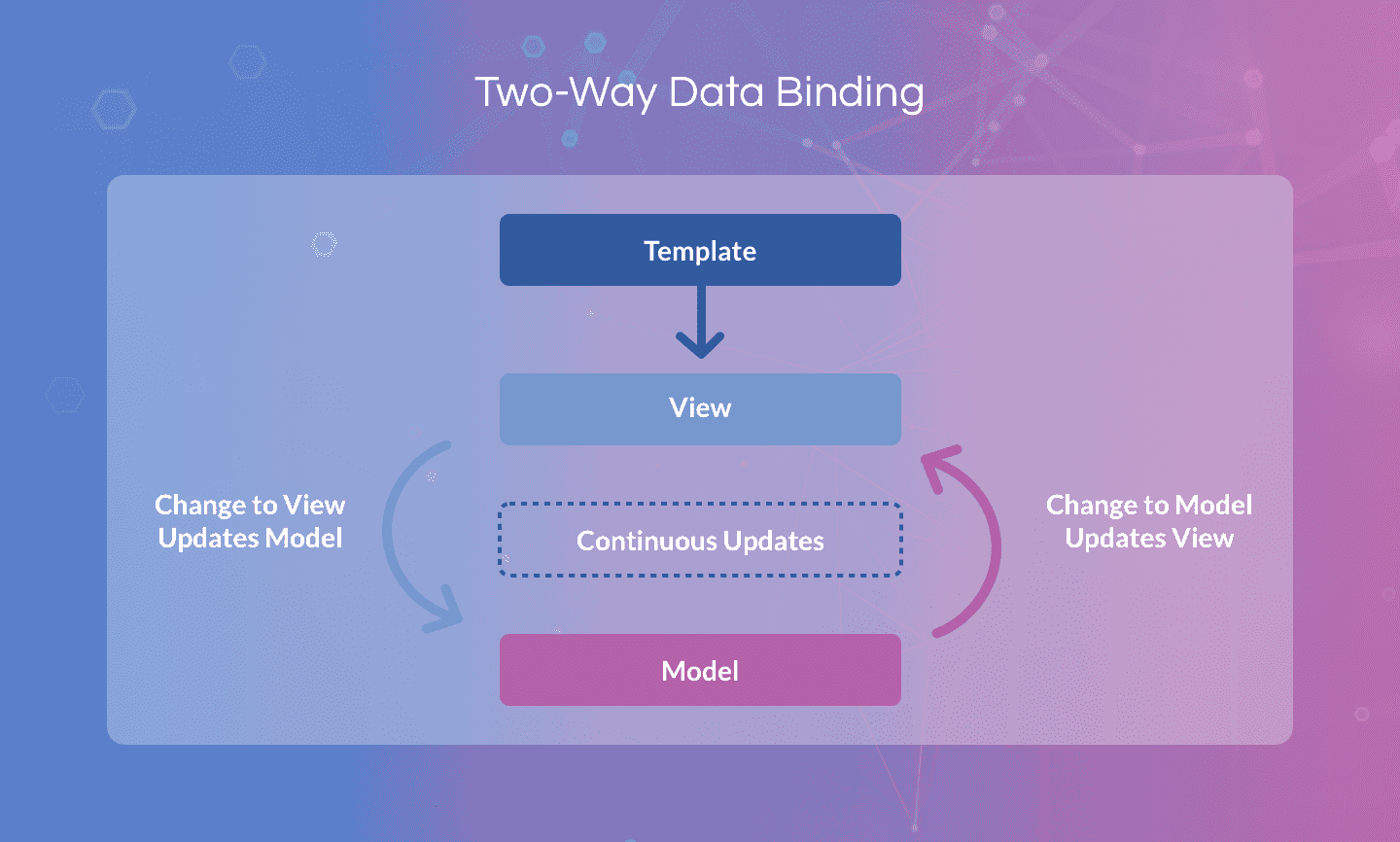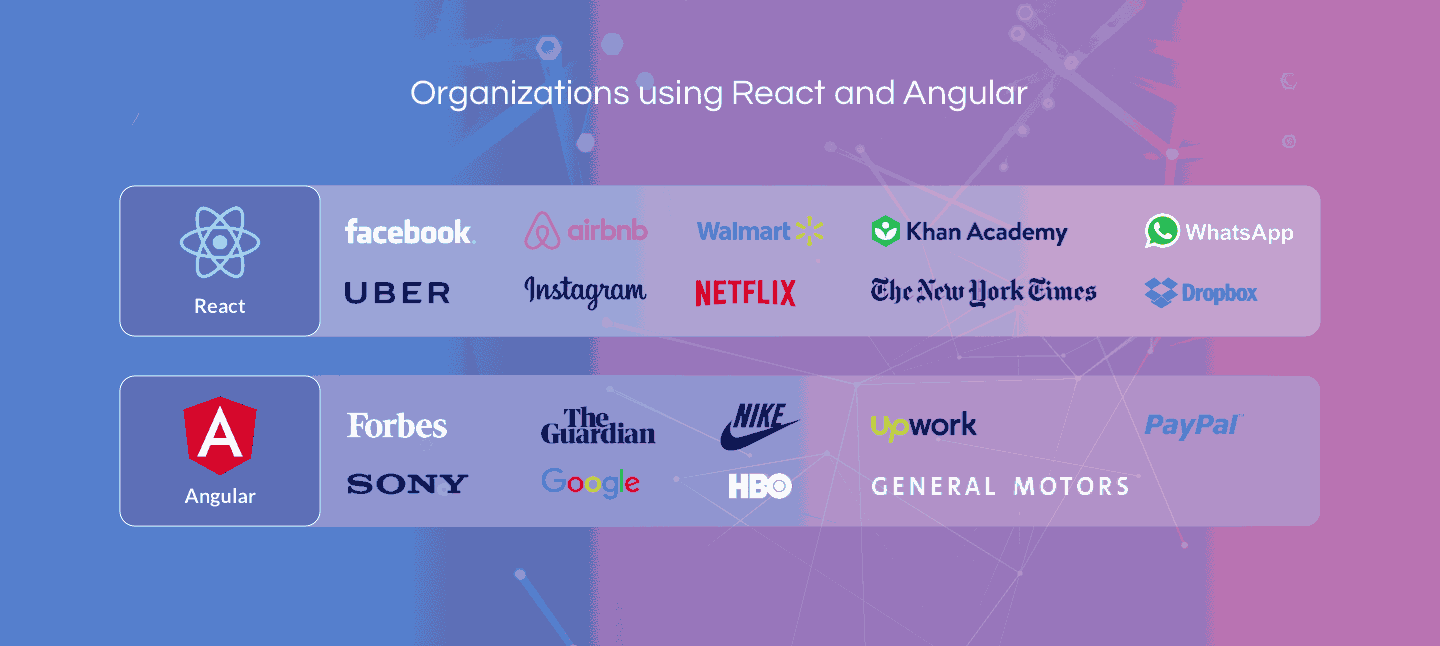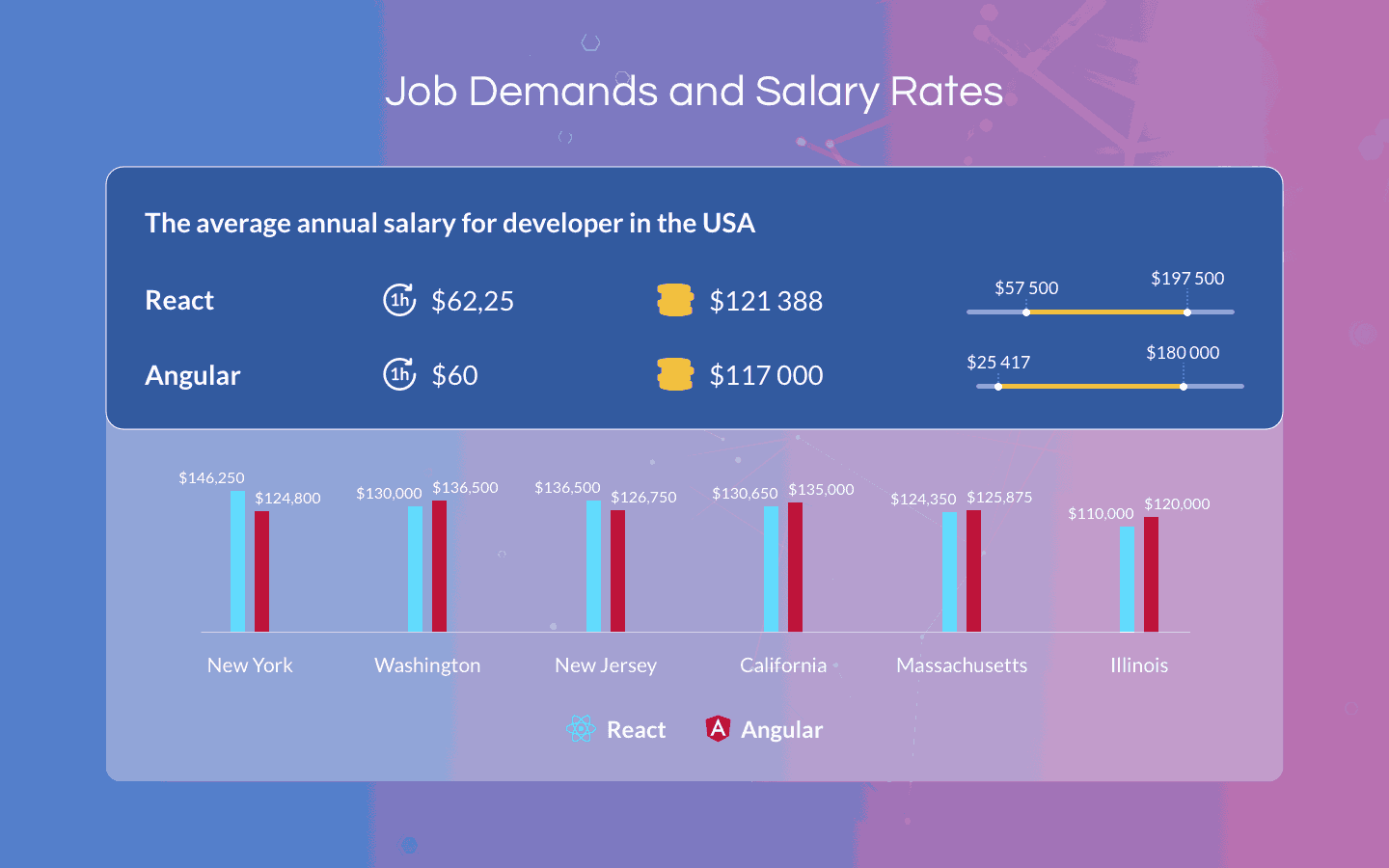The main difference between React and Angular lies in their structure and approach to front-end development. Both are popular JavaScript technologies used to build rich user interfaces, and both are open-source under the MIT license. However, while they serve similar functions, React and Angular differ significantly in their architecture and usage.
The most pronounced distinction is that Angular is a JS framework consisting of all necessary elements incorporated in it, whereas React is basically a library, where the coder must use a set of extra tools and technologies to develop appealing interfaces. However, both of them are suitable for the development of web applications for computer systems and also small devices. Hence, both are reputable and popular among programmers around the world.
Both Angular and React create not only excellent web user interfaces but also efficient mobile apps. React Native is the mobile app development platform of React, whereas Angular has Ionic. Which one will win in the React vs Angular battle ? Both technologies have their advantages and disadvantages. The choice of the tech stack is highly dependent on a set of factors including project requirements, the type of an application, budget constraints, timeframe, etc.
In this article, we’ll explore React vs. Angular, comparing their features and strengths for front-end development.
Definition and History
Angular is a front-end web development framework created by Google. It is also managed by Google, along with several development communities and corporations. Typescript is what Angular is built upon. It is based on JavaScript syntax but has a set of additional capabilities. Misko Hevery from Google developed Angular (also known as Angular 1.0), which was meant to aid specific projects of the company . It was released in 2010 and acquired great popularity among developers. Later, in 2016, Angular 2.0 was released as a newer version of AngularJS to deal with more scalable projects and include features like cross-platform compatibility. Since Angular 2.0 was a total rewrite of AngularJS, it created controversy among developers. There was even no migration strategy from AngularJS to Angular 2.0. Thus, this technology appeared to be an entirely different framework. Since 2016, several versions were released, and currently, Angular 8 is the latest version of the framework.
React is a JavaScript library used for building web interfaces. It was designed and is being managed by Facebook. One of the major benefits of React is an extensive support of an independent community and various organizations.
The history of React development was also eventful, but not as controversial as that of Angular, representing a series of steadily improvements of earlier versions. Jordan Walke from Facebook created React library based on a previous smaller version called FaxJS. React was announced on Facebook in 2011. Its status was turned to open-source in 2013, and React Native, a version for mobile app development, saw the world in 2015. Its most recent update was 16.8.6, released in March 2019.
React vs Angular Evaluation
After we went through the history of React and Angular development, it’s the right time to look at the core characteristics of these two technologies and see how they both perform.
Components
Angular comprises three core components: the Controller, the Model and the View . The Controller acts as the middleman constantly bridging interaction between the other two, the Model and the View respectively. Differences occurring at every step modify the Model. It is passed on to the user through the View component after conversion to the HTML format. Thus, it possesses a systematic and rigid design with well-established components. There is a back and forth communication flow between the two.
In React, the Model is the sole component. In contrast to Angular, there is no View and Controller. React, as it was previously noted, is not exactly framework; it is a library. Hence, it has no rigid structure, which may be considered to be an advantage by one coder and as a disadvantage – by another one. Programmers are free to choose the components as per their discretion and create their own structures. In Angular, this feature is absent One can only use the existing structure of a framework. However, that is also an advantage sometimes because one doesn’t need to bother about choosing a suitable resource, React requires you to adopt additional external tools suitable for the project. With scalable projects, such inconsistency might cause complications
Binding of Data
Angular follows a two-way system: the Model is affected by any new occurrence of a user element. Thus, continuous updating takes place with the View and the Model components, with an integral ‘watcher’ functionality pervading all the three elements in the Angular structure and monitoring every minor change.

In React, binding takes place only in one direction. There is no feedback received by the user as an indication of any alterations taking place in the Model as a result of an input. React has virtual DOM, which is decoded as Document Object Model. The real DOM remains unchanged, and only the virtual version of DOM gets updated. In this situation, the user lacking feedback has to make decisions about the interaction with the Model in the conditions of uncertainty. This kind of data flow is used together with ‘Flux’ architecture.
In regard to data binding, who wins in the React vs Angular battle ? The answer is – it depends. With Angular, you have less hassle as lots of functions are automated, so they do not require your intervention. Coding becomes easier , especially for beginners However, with React you have to be aware of how all elements work to be able to work with the library. Things look more in your control, which can also have its benefits for experienced developers. Especially for scalable applications, React is better, as you don’t need to handle a vast bulk of alteration tracks as created by Angular at every minor change.
React vs Angular Performance
Strictly speaking, neither one can be considered superior over the other in the matter of performance as the pros that some coders praise turn out to be roadblocks for others. The method of data binding and the way of interaction with the DOM can influence the performance.
Effect of data binding. The ‘watcher’ mechanism can influence Angular performance. When HTML code is loaded , a watcher participates in every minor change created by user input. A ‘digest’ cycle is run for every variation, and a watcher is created for each binding of HTML value to the model. Each amendment will be updated: not only the watcher of a given element but all the watchers previously created. React has no such complicated binding mechanism
Interaction with DOM. The method of DOM interaction could also influence Angular performance. Angular uses real DOM to update the changes made to the model. .A number of repeated changes take place affecting the performance of the framework.
Unlike Angular, React processes changes only on virtual DOM. With the loading of the HTML code, a virtual DOM is activated on the server. Thus, the real DOM does not have to take much burden. The DOM interactions take place on the server, thus reducing the load on the browser. A part of the HTML code undergoes alteration while further interaction takes place only in HTML.
There is also a major difference in how both technologies are tested. Angular is tested using Jasmine, while React uses Zest.
Resolving Dependencies
Angular utilizes an object-oriented technique called ‘Dependency Injection.’ It is an inherent part of its systematic structure. The dependencies of functions are separately written and injected, passing on as parameters. However, this mode of dependency resolution has its minor disadvantages.
React has no such rigid dependency structure or provisions for injecting any dependency. Instead, you can find some suitable external tools for executing the dependency injection.
Templates and Directives
Angular has Directives that help us to relate the program with the DOM. Reaching the DOM is only possible through built-in directives. Alternatively, a coder can build his/her own for greater convenience. However, strict syntax makes it difficult to create a directive, which is a critical component of the code helping its incorporation into templates. The latter have elements that link with directives through attributes.
While Angular has directives and templates which are two different things linked together using certain provisions, React does not acknowledge such roundabout methods. React does not categorize between separations, such as templates, directives, etc. The library has templates, but the application logic depends on the template. It means React doesn’t use anything called directives.
Features/ Updates
Angular has more features compared to React, which means Angular is more complicated in use compared to its competitors. Nevertheless, to some coders, abundance in features can be viewed as resourcefulness. The choice of technology depends on project requirements, the structure of an application and your preferences.
Here is a short summary of what we ran through in this article:
- A regular DOM, HTML directives and templates, injection of dependencies, etc. are some distinct features of Angular. Injection of dependencies is not applicable to React. Neither does it use directives with templates. Furthermore, the DOM is virtual, unlike in Angular.
- Features in Angular are mostly built-in and cannot be easily dismissed or altered. It means that to write even some minor code, you must be aware of Angular core features and structure With React, it is entirely different. Users are free to add external libraries to React. However, coders must be adequately trained to make proper choices, which makes development more complicated for newbie specialists
- Both technologies are updated regularly with many advanced features added every time. The latest feature update of Angular took place in May 2019 that included the capability to run and even debug the code at runtime, backward compatibility, and faster rebuild time. For React, examples of updated features in the latest version include Safari DevTools fixes,
Organizations using React and Angular
Numerous reputed organizations make use of both React and Angular for their programs. Angular vs. React both popular and widely used technologies, so comparing their application on corporate and global levels is quite challenging Here is the list of those organizations:
React:
- Uber
- Walmart
- Netflix
- Khan Academy
- Airbnb
- Dropbox
- The New York Times
Angular:
- General Motors
- Forbes
- PayPal
- Sony
- Upwork
- HBO
- Nike
- The Guardian

React vs Angular: Job Demands and Salary Rates
User interface development frameworks are in high demand in the software industry. Angular and React are among those that rule the app dev world today. Hence, job prospects for developers working with these technologies are among the highest. In terms of average yearly salaries that a software developer gets for each, here are some statistics from Neuvoo:
The average annual salary for React developer in the USA is $121,388. It is equivalent to $62.25 per hour. Entry-level salaries are around $57,500, while a senior-level developer can fetch up to $197,500. The average salary is on the high end for the following states:
- New York: $146,250
- Missouri: $146,250
- New Jersey: $136,500
- Virginia: $135,000
- California: $130,650
- Washington: $130,000
- Massachusetts: $124,350
- Georgia: $122,500
- Pennsylvania: $110,575
- Illinois: $110,000
Angular professionals in the USA get an average salary of around $117,000, which is $60 per hour. The wage can range from $25,417 at the minimum to $180,000 at the maximum. The states mentioned below fetch the highest average salaries:
- Washington: $136,500
- California: $135,000
- New Jersey: $126,750
- Massachusetts: $125,875
- New York: $124,800
- Illinois: $120,000
- Kentucky: $120,000
- Louisiana: $118,950
- Oregon: $117,975

Wrapping up the Angular vs. React 2019 evaluation, one can notice that answering a question ‘when to use Angular vs. React’ is hard. Both platforms are among the topmost interface development frameworks. React gives enough freedom to the user to decide regarding almost any aspect of the coding process, but it also presupposes more individual responsibility for the coding outcomes. Angular has a set of rules that limit the user in their actions This feature might be an obstacle to inexperienced developers. At the same time, you can save a lot of decision-making effort.
Angular and React are both strong frameworks that have their loyal communities. It is not easy to decide which technology will best suit your project. However, if one goes merely by the number of users and the number of downloads, React wins this battle with the higher popularity rate.
Anyway, giving absolute preference to one over the other will still be not a good idea. The choice of technology finally depends on the developer’s preferences and the project requirements. Whatever choice you’ll make, let us help you to bring your idea to life. LITSLINK delivers a vast number of IT development services. Contact us for more details on how we can scale your business!




